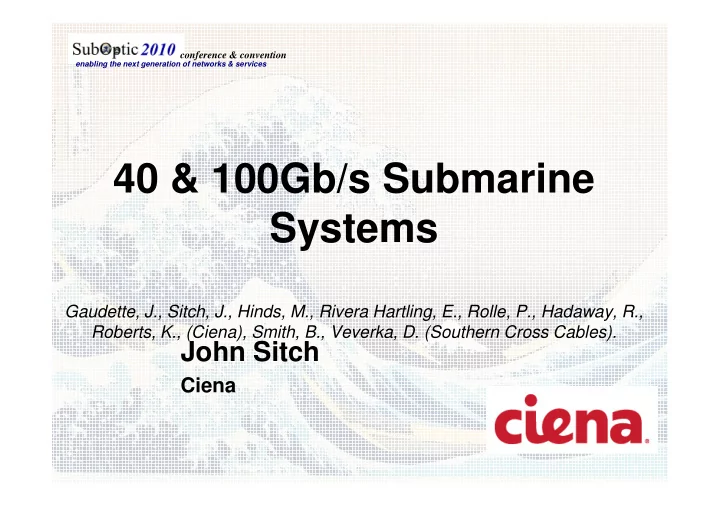

conference & convention enabling the next generation of networks & services 40 & 100Gb/s Submarine Systems Gaudette, J., Sitch, J., Hinds, M., Rivera Hartling, E., Rolle, P., Hadaway, R., Roberts, K., (Ciena), Smith, B., Veverka, D. (Southern Cross Cables). John Sitch Ciena
conference & convention enabling the next generation of networks & services Presenter Profile John Sitch was born in London and educated at Oxford and Sheffield. During his career in industry and academe he has worked mostly with RF, microwave and optical semiconductor devices. Since 2003 he has semiconductor devices. Since 2003 he has worked in optical systems with Nortel and now Ciena. The recipient of a 1996 R&D 100 award, Dr. Sitch was Chairperson of the 2001 IEEE GaAs IC Symposium. John Sitch Senior Advisor, Digital/Optical Systems Email: jsitch@ciena.com Tel: (+1) 613 763 3851
conference & convention enabling the next generation of networks & services Outline • Context • Technology Enablers • Additional Dimensions • Additional Dimensions • Coherent Detection • Digital Signal Processing • Examples • Outlook
conference & convention enabling the next generation of networks & services Why 40G? Why 100G? • Many fibres are full, new cables are costly • Squeezing in more 10Gs brings diminishing returns – Restricted amplifier b/w & total optical power – Restricted amplifier b/w & total optical power – Wholesale replacement of mux/demux • Higher spectral efficiency required – More bits/sec/Hz • 40G/100G in 50GHz channel • How?
conference & convention enabling the next generation of networks & services Technology Enablers ���� • Key Technology Components ������� ��������� – Additional Dimensions – Coherent Detection – Coherent Detection – Digital Signal Processing ������������� ����� • Proof Point: Coherent 40G DP-PSK deployed in repeatered submarine applications since 2008
conference & convention enabling the next generation of networks & services Additional Dimensions • Multiple amplitude levels (ASK) – Stringent OSNR requirements • Phase and polarisation – Increased number of bits per symbol. – Increased number of bits per symbol. • Subcarrier modulation – Increased spectral efficiency Q (1,1) (0,1) I (0,0) (1,0)
conference & convention enabling the next generation of networks & services Coherent Detection – Natural for Multidimensional Signals • Linear field frequency translation – Preserves amplitude, phase & polarization information – Enables DSP on the received signal, correcting: • Chromatic dispersion • Chromatic dispersion • Polarization state (PMD, PDL) • Spectral selectivity – Co-FDM, colourless optical network egress • Optical gain – Improves receiver sensitivity
conference & convention enabling the next generation of networks & services Digital Signal Processing • Goes hand-in-hand with coherent detection: – CD & polarisation artefacts are now linear phenomena, amenable to linear processing – Allows continuous line system observation • Remote real time access to important line system parameters parameters
conference & convention enabling the next generation of networks & services Real time DSP Q probability • Continuous self- 12.20 optimization – deals with 12.10 transients – reduces time reduces time Q 12.00 variability – 5 σ variation, 11.90 0.15dBQ 11.80 -5 0 5 Standard Deviations from Mean Overnight soak on a 3,000km link with multiple 10G & 40G wavelengths
conference & convention enabling the next generation of networks & services Design Flexibility Attribute 40G LH 40G ULH 100G LH Modulation QPSK BPSK QPSK Polarisations 2 2 2 Subcarriers Subcarriers 1 1 2 2 2 2 Symbol Rate 11.5 G 11.5 G 14.4 G Bits/symbol 4 4 8 Nominal reach 4,000 km 9,000 km 2,000 km All using the same chip set!
conference & convention enabling the next generation of networks & services Performance Field Trial Measurements Configuration: • Dark fiber 4 • 6 λ λ λ group swept across λ dB OSNR) band • Idlers used to control 3 launch power launch power System Margin (dB • PSK prefers CD (less impact from XPM) 2 Result: 40G and 100G over 1 40Gb/s 2P-QPSK 4000km SCCN Seg. D 50GHz channels with 40Gb/s 2P-BPSK 8000km SCCN Seg. C deployable margins 100Gb/s 2P-QPSK 2000km Caribbean 0 1540 1545 1550 1555 1560 Wavelength (nm)
conference & convention enabling the next generation of networks & services Summary • Higher spectral efficiency will prolong the service life of existing submarine systems • Adding phase modulation & polarization diversity improves spectral efficiency improves spectral efficiency • Coherent detection, allied to DSP, allows cost- effective implementation • XPM can be dealt with – DP-PSK is deployable as an overlay (existing deployments with 10G since 2008)
conference & convention enabling the next generation of networks & services Thank you Any Questions?
Recommend
More recommend